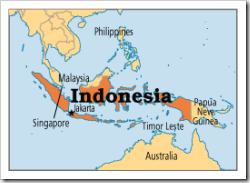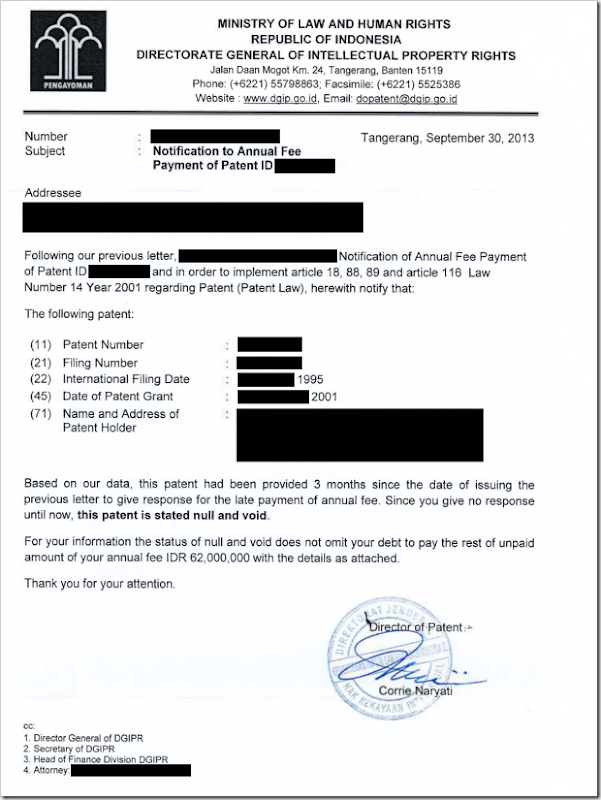 I have become aware that some (former) applicants for Indonesian patents have recently received letters from the Directorate General of Intellectual Property Rights in Indonesia requesting payment of annual maintenance fees relating to abandoned patents dating back to the 1990’s.
I have become aware that some (former) applicants for Indonesian patents have recently received letters from the Directorate General of Intellectual Property Rights in Indonesia requesting payment of annual maintenance fees relating to abandoned patents dating back to the 1990’s.Thanks to the efforts of the World Intellectual Property Organization (WIPO), various national patent offices, attorneys and agents, and even the occasional blogger, many patent applicants are now conscious of the ‘registration’ and ‘maintenance’ scams being perpetrated by unscrupulous operators. Unsurprisingly, therefore, a number of recipients of letters purporting to come from the Indonesian authorities have responded with suspicion, and referred the correspondence to their patent attorneys for verification.
In this case, it appears that the letters are genuine. It looks like the Indonesian IP Office really is requesting payment of thousands of dollars in overdue maintenance fees on patents which were abandoned perhaps a decade or more ago!
An example of such a letter (with names and numbers redacted to protect the identity of the applicant and attorney in question) is included below. But first, a little background.
Maintenance Fees Generally
Most regional and national patent offices levy maintenance fees on granted patents. Many also levy such fees on pending applications. Maintenance fees (sometimes called ‘renewal’ fees, ‘continuation’ fees or – when due yearly – ‘annuities’) serve two policy purposes. Firstly, the requirement to pay ongoing fees to keep a patent in force ensures that the proprietor has an incentive to abandon the exclusive right if it is not providing a sufficient commercial return. This frees up the patented technology for use by other innovators. Secondly, maintenance fees subsidise other costs of operating the patent office, enabling the fees associated with filing, search, examination, and other services to be kept at affordable levels.There are a number of different models for payment of pre-grant maintenance fees. Some patent offices, such as IP Australia and the European Patent Office (EPO), simply start charging annual fees (in Australia at the fourth anniversary of filing, and in Europe at the third) regardless of whether a patent has yet been granted. If a fee is not paid when due (or within any applicable grace period) the application simply lapses.
However, in some countries any maintenance fees which become due while an application is pending are not payable until (and unless) a patent is actually granted. For example, in New Zealand (under the current Patents Act 1953) the first maintenance fee falls due before the fourth anniversary of the filing date of a New Zealand patent application (or the international filing date in the case of a PCT-originating application). If the patent has not yet been granted by this stage, the fee is not payable immediately. Instead it is due within four months from the official date of sealing of the New Zealand patent. Of course, if all required fees are not paid by the relevant deadline, the patent lapses.
Pre-Grant Maintenance Fees in Indonesia
Indonesia, like New Zealand, does not require maintenance fees to be paid while an application is pending. Nonetheless, annual fees accumulate from the first year following filing of the application, and become due when a patent is granted. The deadline for payment of these accumulated fees is one year after grant of the patent. If the fees are not paid, the patent lapses.Technically, I suppose, this means that the patentee has a full year following grant during which to evaluate the real commercial value of the Indonesian patent. If the patent is not worth maintaining, then the fees can be withheld and the patent allowed to lapse.
But this raises a couple of questions.
- If the patentee never has any intention to pay the outstanding fees, is the patent enforceable during the first 12 months? I would think that the answer must be ‘yes’, because the subjective intentions of the patentee cannot be a factor and, in any event, if grounds to enforce the patent arise then the patentee would certainly change their mind about paying the fees.
- If the fees are not paid, when does the patent lapse? Is it deemed never to have been enforceable, or will it nonetheless be considered to have been a valid patent during the first 12 months?
Requests for Payment of ‘Old Debts’
It seems that the Directorate General of Intellectual Property Rights in Indonesia has decided that the answer to the second question above is that the patent lapses when they say it lapses, i.e. the date on which it is officially declared ‘null and void’. This is not the date on which it was granted, or even the date 12 months later when the fees were not paid. It is, in fact, some later date, following a warning letter permitting late payment of the fees due, a failure of the patentee to respond to the warning letter, and a subsequent official decision to declare the patent null and void.Furthermore, as far as the Indonesian authorities are (now) concerned, the patentee had the benefit of the patent, at least in principle, right up until the date on which it officially lapsed, and therefore owes all of the relevant accumulated fees – including any late payment surcharges!
In the case represented by the letter below, the original filing date of the application was in 1995, the patent was granted in 2001 (thus the accumulated fees were due in 2002), and was finally declared null and void three years after grant in 2004.

In all, by the time the patent lapsed in 2004, eight years worth of maintenance fees were due. For each of the six years prior to grant, 24 months penalty fees were also owing (since the fees had been due since grant in 2002), while for the seventh year 12 months penalty fees were owing.
The total above looks positively frightening in Indonesian Rupiah! Even in Australia dollars it is not insignificant – IDR 62,000,000 is equivalent to about A$5700. This amount is owing on a patent that the owner considered abandoned effectively since grant in 2001.
Conclusion – To Pay or Not to Pay?
This all raises the questions of whether these fees are really payable, and what the consequences of non-payment may be. It is not generally a good thing to owe money to any government, and so recipients of these letters probably need to take them reasonably seriously.Now I certainly do not wish to speak ill of the Indonesian government – Australia is already facing sufficient challenges in its relationship with one of our closest and largest neighbours. It seems to me, however, that calling in these alleged patent maintenance debts, so many years after they were incurred, raises legitimate questions of fairness as well as about the correct interpretation of the relevant provisions of the Indonesian patent law.
In Australia, the options for challenging such a request for payment would potentially include application to the Administrative Appeals Tribunal (which could be fairly cost-effective) or certainly to the federal courts (which would be much less so). I have no idea how a dispute over these payment requests could be resolved in Indonesia.
If you have any information about this issue, including further reports of requests for payment by the Indonesian government (I would be especially interested to hear of cases involving applicants from outside Australia), or about the mechanisms available to challenge these requests in Indonesia, please let me know either in the comments below, or privately via email.
Tags: Indonesia, Maintenance fees, Patent Office


0 comments:
Post a Comment